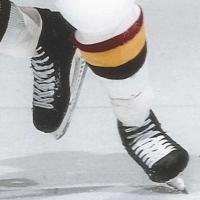Slate
Blackcurrant
Watermelon
Strawberry
Orange
Banana
Apple
Emerald
Chocolate
Marble
Slate
Blackcurrant
Watermelon
Strawberry
Orange
Banana
Apple
Emerald
Chocolate
Marble
-
Content Count
2798 -
Joined
-
Last visited
-
Days Won
90 -
Feedback
0%
Content Type
Profiles
Forums
Downloads
Gallery
Store
MSH News and Articles
Everything posted by flip12
-
I thought they were new ones designed to best fit their footscan matrix.
-
Today’s 3-piece elbow archetype is also Jofa. Alpha DX looks closer to a Jofa copy to me than a return to the Projekt pattern.
-
Interesting. How do you mean?
-
Was going to say the same as @Vet88. The two Projekt releases seem to be Warrior’s only iconic elbow, but they abandoned it in favor of the standard Jofa copies. Sher-Wood’s Code V looks like a pretty faithful rendition of Projekts though:
-
I don’t think any top end skate today qualifies as heavy. We’re in the light and lighter era. Whenever I switch between Grafs and MLX in the same session, it’s night and day in weight perception. Cases in point: 1. Grafs were light before the Vaporization of hockey skates. 2. MLX are unnecessarily weighty due to the MacGyver TM holder attachment system.
-
Ah. Should the asym. toe boxes really count toward HypeLight’s Mako-ness? It’s Bauer’s 3rd release since that change. I guess if you’re looking for Mako presence in Bauer skates overall. Did the Mako have an intentionally flexible outsole? I thought it was the opposite—an increased torsional rigidity —the Mako featured there. I know the original Home Depot SE Mako had some tendency toward flex (and shearing) in its outsole, but not as an intentional aspect of its performance properties.
-
What are the Mako similarities you see? Cosmetically, there is some resemblance in the grey to black fade.
-
Was the Mako designed with flex in its outsole? I don't get the idea. HT's video is great at regurgitating the marketing jargon, and that includes mentioning it has 5% flex. 5% of what? In which axis? How does this affect the holder? What about heel striders like the OG Vapor Monster, Pavel Bure? Though, to be fair, Bure's early Vapors had TPU outsoles, but that's mostly what he had used up until that time. I found out by using boots without any lateral stiffness in the ankle that I was bottom out on turns where I was leaning back on my heels. Shifting my weight toward my toes made it impossible to bottom out, and now I can't recall the last time I've done it in a stiffer skate. Agility to me, then, seems to be about the front of the blade as well. Props to Bauer for trying something different, but I'm stumped about how it's supposed to work.
-
Indeed! There were several Penguins at the end of the oughties that wore them: Talbot and Fedotenko as well. About a handful, but that's a lot considering it was still a prototype skate with very little presence behind it. The difference between Gonchar's and Lemieux's skates and the others', though, is that the former are the only two I've seen with the Scott Van Horne build that's reminiscent of a 90's CCM Tacks boot, with the silver heel wedge. Both Gonchar and Lemieux were Tacks wearers, so it makes sense they would use that construction, but it died out after them as far as I can see. Fedotenko, Malkin, and Talbot (as well as Byfuglien and the other early MLX guys) all had skates that resemble the eventual MLX "genie boots" stock look, only with fewer bumper pieces glued on. I wonder when Lemieux became an investor and how that influenced his players using the skates (or perhaps the other way around or a little of both). It would be an interesting history to hear, especially seeing how big of an impact the Scott Van Horne skate has had on the hockey skate market overall.
-
I’ve heard it can feel less wrapped or less connected.
-
That’s the Yeezy Boost 350 influence.
-
Hyperlight’s jewel next to the eyelets is an alarming rip off of True’s Chrome Tornado. In general, they look like Yeezys.
-
Last I saw he was in VH, True and Mako. Haven’t seen a shot of him with MLX in some time. As @the_game said, those are prototype MLX skates. Gonchar’s the only other one I’ve seen wear a similar looking MLX prototype, prior to the stock look they settled on.
-
Purely a crazy conjecture. I wonder if a significant degree of oversized holders at the elite level is rather an artifact of pro players getting smaller sized boots as they graduate into a proper custom fit. If they were used to wearing skates that were a bit too big overall to compensate for a bad fit in width, for example, they'd be used to skating on an oversized holder compared to the size that would come with the skates that are tailored to their feet. In order to maintain the blade-ice feel they're used to, it would be easiest to just install the bigger holder and call it a day. That would be interesting because it would mean instead of using an oversized holder to improve performance, it would rather be about maintaining a system (blade-ice feel) that evolved on a faulty basis (oversized boots).
-
I wonder if there's a characteristic that makes some players more adaptable and others more particular in what works. Some people just don't care, so when they hear there are different options available, where a different setup might be more suitable for them, they get a little tired looking having to consider something other than what they already don't know. It's not even that all of the don't care group are good players. For me, I started playing at 13, so it didn't seem realistic for me to go far with my abilities, but I was hooked on the equipment from day 1. Eventually I found things that worked, without understanding why they worked. It has taken a lot of trial and error, but I think I have narrowed down what the most influential elements of my equipment are, and some of them are really surprising. What's also surprising is the difference it can make. When I narrow in on a good setup, things just happen and it's almost like I'm a spectator enjoying the feeling of being able to skate and move the puck without focusing on it. It's one of the most enjoyable activities I can think of. That it has the personal history of the equipment search and development process involved is only a bonus, as it makes it intellectually stimulating as well.
-
I think @Bladoww may be referring to his old boots having toe spring and the new ones lacking it. https://theshoesnobblog.com/toe-spring-whats-it-all-about/
-
One piece boots tend to be stronger where the quarters turn into the sole of the boot, but they are not automatically stiffer overall. FT1s had a nice give to them in the quarters, much more than 2S Pros. TF7s also have a notable suppleness compared to Tacks say.
-
@marka I think it was the tongues throwing some people off? The thicker TF7 tongue gave the impression of less forefoot volume and overall length compared to the thinner TF9 tongue. Between the TF9 and TF7 the shell form is the same, foam type and thickness aren’t noticeably different, liner is of course slightly sleeker on the TF9, but the major differentiator is the tongue.
-
Maybe sneak the idea in there so he has a chance to see what the difference is. It can be a good idea to have a backup pair of skates for someone skating that much and if you present that angle to him, maybe he’s be up for trying them out at a stick and puck or a practice where he has his usual pair on the bench. It just takes a minute to change skates, and then he can get a sense of how game ready his boots are, both pairs. Maybe he doesn’t notice the increased give at the top of the quarters because he already laces lower to have more range of motion there. He may just be lacing a little more snug as the boot has softened up, achieving a similar level of support as he would in a fresh pair. In that case, it might be a possibility to get the new pair in on a rotation, so he doesn’t go through a full break-in and break-down cycle in one pair and then have to start all over again. If you can show him some upsides of giving the new pair a try, he may see a benefit in switching to the new pair himself and decide to retire the current pair. On the other hand, if he tries them and doesn’t see any benefit from the increased stiffness you’ll have as good an answer to you lingering question of whether he’s leaving performance on the table or not as I think you can get. I disagree with the notion that any give in a boot means it should be replaced. There is a broad range of ankle support required to skate one’s best. Some players need a new pair of skates as soon as they open up a bit, others lace in ways to ensure their ankle range of motion is unhindered. Just look at Kirill Semyonov, who just signed with Toronto out of Omsk. He skips two eyelets in Vapors and his career doesn’t appear to be suffering at all due to his skating style.
-
At least you can shoot the runners straight into the recycling!
-
Yet they're mounted with RMS, adding to the mystery.
-
Only in the Praux Custom option, from what I could see, but they had it there. It’s the Kane I’m looking at, and looking again, it looks like it might have some of his mods to the stock Shanahan. PSHS’ Kane looks like a stock Shanny. I have nothing against Base. I just got a Hossa Pro blade from them.
-
MyBauer, Prostockhockeysticks, also Base, yeah.
-
But you can order a brand new Shanny if you want, as opposed to a 1st gen. Synergy.
-
You're right, maybe "simple" wasn't the right adjective. I agree with your insistence that it involves more than setting a price on a single tier. It seems it didn't come through in my last post, but in an effort to be brief, I didn't elaborate on how that not-so-simple calculation would necessarily involve a reevaluation of the entire line underneath the custom tier, as the mapping between previous top tier skate sales and new custom skate sales wouldn't be 1:1. That's why I was envisioning the calculation would have a volume range estimate, hinting at the indirect translation between current and imagined skate lineup schemes.



